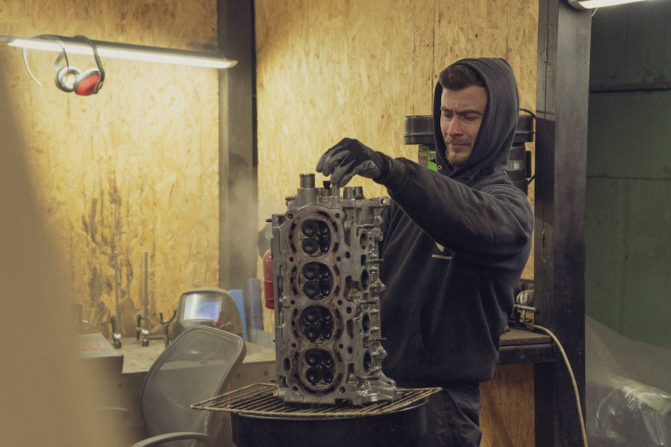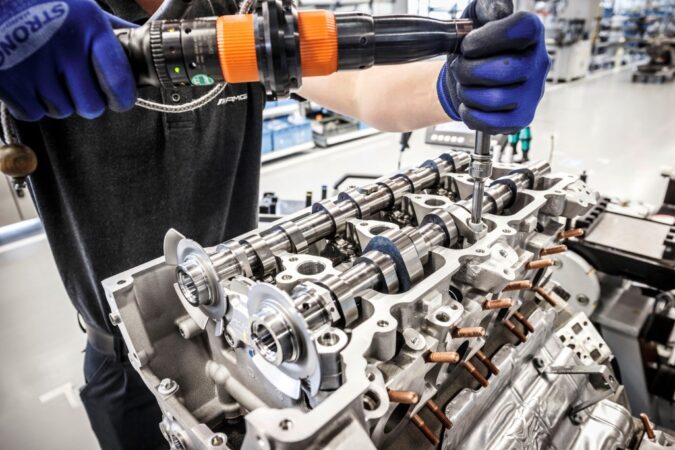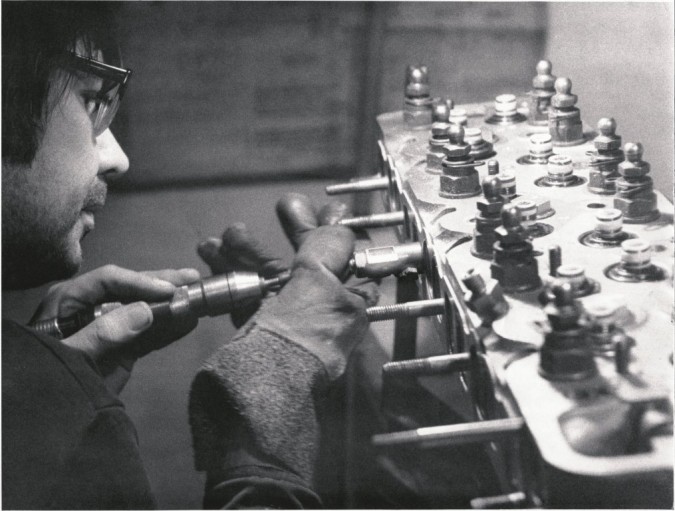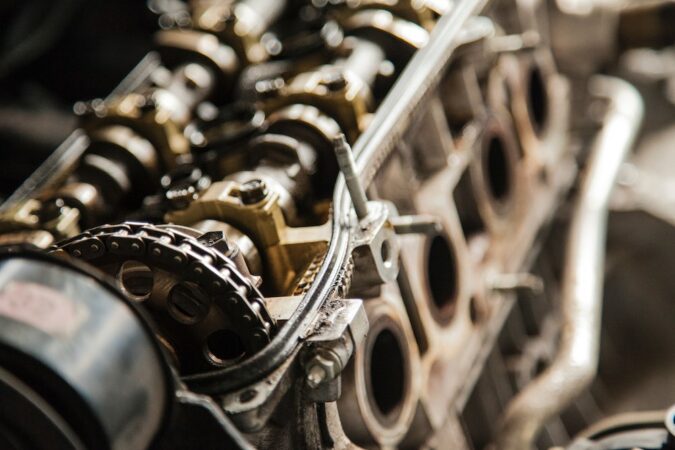A head gasket is essential for a car to run smoothly, which means it can be quite costly to replace. We’ll be discussing further concerning how much a head gasket replacement cost would be, the types of head gaskets, and more. Hopefully, we’ll help you learn more about head gaskets and make an informed decision about repairing them should you need to.
Head Gasket
A head gasket is absolutely crucial for your car’s engine as it connects the engine block to the cylinder head. The purpose of the head gasket is to prevent leakage of coolant and oil into the engine cylinders, which is something you don’t want. The head gasket seals parts where the coolant travels through the engine, keeping it cool and preventing overheating. It also helps to ensure optimum compression as it seals the combustion gases inside the cylinders.
When a head gasket fails or is “blown” as we often hear on TV shows and movies, it allows engine coolant and oil to leak into the cylinders. Needless to say, a leak like this can cause your car to lose performance and fuel efficiency, and can even cause more severe damage. Sometimes you might even have a complete failure and the car won’t run.
Before we get into the head gasket replacement cost, you should know that there are several types of head gaskets and they can affect your repair or replacement cost. Here are some head gasket types you should know about:
Head Gasket Types
1. Multi-Layer Steel
Most modern cars come with multi-layer steel head gaskets. As the name suggests, these head gaskets feature multiple layers of steel, around two to five depending on the engine’s needs. An elastomer or adhesive joins the layers together.
The main feature of a multi-layer steel head gasket is that it can withstand greater pressure and temperatures. As a result, they’re ideal for use in cars with high compression such as diesel cars.
2. Copper
Copper head gaskets are made out of solid copper, making them stronger than aluminum and steel. They’re also regarded as being more reliable. However, copper head gaskets can be quite difficult to install as it requires special machinery to install. This, in turn, makes them more expensive to manufacture, and more expensive to replace should you need to.
Copper head gaskets are not often used in modern cars due to the effort and cost needed to install them. However, because of their stronger nature, they are still often used in high-performance cars.
3. Composite
Composite head gaskets were often used in older cars in the 1980s, and they are usually made out of graphite. While graphite is strong, it’s still not as durable as the other materials and it doesn’t prevent leaks very well. Because of this, they soon fell out of popularity. It’s likely that your car has a composite head gasket if it were made prior to 1990.
Blown Head Gasket
We hear that quite often on TV shows and movies. The main character takes their broken car to the shops, and the mechanic says “you’ve got a blown head gasket“. Maybe you’ve experienced that in real life and now you’re trying to find out what it all means. Well, a blown head gasket simply means that your engine’s head gasket has, well, blown. In other words, it’s broken and it doesn’t seal your engine correctly anymore.
As mentioned earlier, a broken head gasket won’t seal the engine block properly and will leak coolant and sometimes oil into the cylinders. This will cause a number of problems, from loss of performance due to compression issues to overheating. On top of that, it could cause further damage to your engine’s internals if left unfixed.
Blown Head Gasket Symptoms
If you suspect your car has a blown head gasket, here are some symptoms you could look out for:
Symptoms For A Head Gasket Replacement #1: Bubbles In Radiator
A blown head gasket could allow combustion gases to escape and enter the cooling system, causing bubbling in your radiator. A good head gasket not only seals the coolant from getting into the cylinders but also prevents the hot pressurized combustion gases from escaping to the cooling system.
To see if you have bubbles in your radiator, wait until your car has cooled down – we recommend for about two hours after driving – and remove the radiator cap. Then, turn on your car and observe the coolant in your radiator. A bit of bubble is normal, it’s usually just trapped air escaping your car’s radiator. However, if the bubbles persist after idling for 10-20 minutes then it could be because of a blown head gasket.
Symptoms For A Head Gasket Replacement #2: White Exhaust Smoke
White thin smoke is normal when you start your car on a cold morning. That’s just condensation from moisture in your car’s cylinders. However, if the smoke is white and thick, and it persists even after a few minutes of idling, then it’s likely because your car’s coolant has entered the engine’s cylinders, caused by the blown head gasket.
The only way for large amounts of moisture to enter your engine’s cylinder is through a blown head gasket. As it enters the cylinder and you turn on the car, the coolant will get burned along with the air and fuel, resulting in white exhaust smoke. If you drive along and the white smoke persists or gets even worse, then we recommend stopping and getting your car to the shops as soon as possible.
Unless your car runs on diesel, it really shouldn’t produce any colored smoke. Exhaust gases are supposed to be clear and transparent. If your car’s exhaust is producing colored smoke, you can learn more about what it means in this video below:
Symptoms For A Head Gasket Replacement #3: Difficulty Starting The Engine
As we’ve mentioned, a blown head gasket could allow coolant into the cylinders. Not only does this causes white exhaust smoke, but it can also prevent the fuel and air mixture in your cylinders from properly igniting. As a result, your car might have difficulty starting its engine, or even if it does start it can be very rough.
Modern cars come with fuel injection and should have no trouble starting the engine unless the battery has started to lose its charge. Other possible causes of difficulty starting the car include faulty spark plugs and ignition coils. Of course, if you have an older car with a carburetor then that could be the problem with a rough engine start. If none of those things seem to be the cause, you will need to check the head gaskets.
Symptoms For A Head Gasket Replacement #4: Frequent Overheating
A blown head gasket can cause overheating because of three reasons:
- Oil gets mixed into the coolant, reducing the coolant’s ability to transfer heat away from your engine.
- A significant amount of coolant has escaped the cooling system into the cylinders, causing your cooling system to lose the optimum amount of coolant.
- Loss of pressure in the cooling system, lowering the coolant’s boiling and resulting in your coolant burning and turning into steam.
Overheating can be caused by a number of reasons, such as a broken thermostat, faulty water pump, or radiator leaks. If you have ruled out the other possibilities, then it’s possible that you have head gasket issues with your car.
Symptoms For A Head Gasket Replacement #5: Loss Of Pressure In The Cooling System
A car’s cooling system is designed to pressurize as the engine warms up. The reason behind this is that pressurized coolant has a lower boiling point than unpressurized coolant. This is important so that the coolant doesn’t boil and turn to steam as you drive along. If it does, it will cause overheating even under normal driving conditions.
Since a blown head gasket can break the closed nature of your cooling system, it can cause a loss of pressure. You can buy or rent a testing kit to see if your car’s cooling system still has the correct pressure. Here’s how to test your cooling system’s pressure:
Symptoms For A Head Gasket Replacement #6: Mixed Oil And Coolant
A head gasket is responsible for keeping both the coolant and oil in its place while it’s running through the engine. That’s why if you have a leak, the two fluids may mix together and that’s not something you’d want in your engine. Coolant entering the engine can reduce lubricity and cause degradation in your engine. Meanwhile, oil mixing with your coolant can cause overheating even under normal driving conditions.
You can take a look at your oil dipstick and inside the radiator to see if the two fluids have been mixed. Coolant in oil usually has a foamy consistency and is cream in color. Meanwhile, oil in your coolant usually results in black specks floating to the top of the coolant in the radiator.
Symptoms For A Head Gasket Replacement #7: Cylinder Compression Loss
Compression loss in one or more of the cylinders is usually a sign of a blown head gasket. Your engine’s cylinders are supposed to be sealed so that they can trap the combustion gases, creating energy and using it to power the crankshaft and move the car.
The pressure inside the cylinders is usually around 100 to 1,000psi, depending on which stage of combustion it’s in. In diesel engines, it could go all the way to 2,000psi. To determine if your car has a loss of compression, you will need to test the cylinders. Here are two ways to do it:
- Compression test: insert a compression tester into the spark plug port of the cylinder to determine how much pressure they produce.
- Leak-down test: this test uses a leak-down tester to force pressurized air into each cylinder via the spark plug port and see if it holds. If some cylinders don’t hold, then you may have a blown head gasket.
A leak-down test is a more accurate way of determining whether you have a compression leak or not. However, keep in mind that bad piston rings and valves can also cause compression loss. Here’s how to do a leak-down test:
Head Gasket Replacement Cost
With just about any other parts replacement, the cost will vary from one car to another. The head gasket replacement cost is no exception, so we can only give you a rough estimate of how much it will cost.
A Toyota Corolla for example will set you back $294 on average for a head gasket set. Meanwhile, a head gasket set for a Toyota Tacoma is slightly more expensive at $310 which doesn’t sound too bad. However, you need to watch out for the labor cost as it can be very expensive.
The average total cost you will need to pay could be anywhere between $1000 – $2000, depending on the complexity of your engine and your repair shop’s labor rate. On top of that, you will typically need around another $150 to refill your car’s radiator coolant and oil, as the system will need to be drained during the process.
If you are looking specifically for information about Subaru head gasket problems read our guide here.
How Much Does It Cost To Replace A Head Gasket
The reason why the replacement cost is so expensive is because of the complicated process of replacing the head gasket, hence the high labor cost. For most cars, a head gasket set is typically between $200 – $500. The repairs are expensive because of the labor cost.
In order to replace your car’s head gasket, your mechanic will need to do the following:
- Drain all oil and coolant from your engine.
- Remove a significant portion of your engine, including the camshafts, cylinder heads, and the broken head gasket itself.
- Clean the surface of the engine block and bolt holes.
- Fit in the new head gaskets, the cylinder heads, and everything else that was taken apart before.
- Set the camshafts and timing gears back to your car’s exact orientation, making sure it runs smoothly as it should.
Our explanation above is an oversimplification of what needs to be done, as replacing the head gasket is a long and tedious process. That is why we don’t recommend you do it yourself unless you’ve head professional training and the right tools. However, if you’re a DIY enthusiast and want to do it yourself, then we urge you to learn how to do it properly. Otherwise, you may cause further damage leading to more expensive repairs.
This process can take anywhere between six hours to a few days, depending on the severity of the damage. Your repair shop will probably recommend you to leave your car at the shops for a couple of days. Now you know why it’s so expensive to replace a head gasket.
Is It Worth Fixing A Blown Head Gasket
There are some circumstances where a head gasket replacement might not be worth it, such as:
- Your car is very old and you were going to replace it anyway.
- Excessive cost, whether it’s because there’s a premium for your car’s head gasket or very expensive labor cost.
- You don’t have funds available for a repair cost.
- You’ve been doing a lot of repairs on your car lately and it’s taking a toll on your funding.
If any of the above is the case, then it might not be worth it to go through with the repairs. Of course, we recommend you fix the car as a head gasket is essential to the car’s operation. However, if any of the circumstances above apply to you, then you might want to weigh other options, such as selling your car as-is. That being said, if you don’t intend to replace the car and your car is otherwise healthy, then by all means go ahead with the repairs.
What Causes A Blown Head Gasket
There are no specific causes for a blown head gasket. Unlike, for example, wheel bearings which can wear out more quickly due to rough roads, a head gasket can break simply because of wear and tear. When a head gasket is blown, there’s usually a physical crack or break in the seals. This results in combustion gases escaping the cylinders. In severe cases, it lets the coolant and oil into the cylinders.
It’s more likely for you to experience a blown head gasket if you have an older car, as the part is probably nearing the end of its lifespan. Also, if you have a highly tuned car, it could also break the head gasket prematurely.
The reason is that tuned cars with more performance can increase the car’s compression and working temperature, which adds stress to your engine and could lead to premature damage. That is why it’s important to pay attention to your engine’s parts and internals should you intend on tuning your car to get more performance.
FAQs On Head Gasket Replacement Cost
If you’re still curious to learn more about a head gasket replacement cost, our FAQs here might help…
What Is A Head Gasket
In essence, a head gasket is a gasket that sits between your engine block to the cylinder head. This is crucial, as the head gasket creates a seal between these 2 major parts of an engine. As such, the head gasket allows for coolant to circulate around the engine and cool it down, without leaking into the engine itself and mixing with motor oil. In addition, the head gasket also seals the engine’s combustion chamber, thus keeping gases and fuel within the engine. This helps to ensure that compression can be retained for optimal performance.
How Much Is A Head Gasket
A head gasket replacement cost is never cheap, regardless of what vehicle you drive or what engine it’s powered by. Technically speaking, the parts themselves are relatively inexpensive as far as most automotive servicing goes. You can find the head gasket itself selling for between $200 to $500, depending on the make and model of your vehicle. Although, the reason why a head gasket replacement cost can sometimes reach far above $1,000 is due to the labor required to replace it. It’s a tedious process that requires draining out all the oil and coolant, taking apart much of the engine, and refurbishing its internals, before putting it back together and resetting the timing.
Where Is The Head Gasket Located
The head gasket can be found in between the cylinder heads and the engine block. Its role is primarily to seal those 2 aforementioned components together. Hence, ensuring that coolant and oil can flow throughout the engine to keep it cooled and lubricated. Yet, without having them mix with one another or leak into the engine itself. Moreover, your engine’s head gaskets are also responsible for sealing the combustion chamber. It makes certain that combustion gases and fuel don’t leak out of the engine, and maintains your compression ratio for optimal combustion and performance.
How Do You Blow A Head Gasket
For the most part, a head gasket can blow due to regular wear and tear. As it forms the primary seal between the engine block and cylinder heads, it undergoes immense strain during its lifetime. The head gasket is exposed to high temperatures within the engine, as well as high compression and pressure. This is especially the case if you’re running a modified engine or high-performance car. With higher temperatures and compression, it’ll wear out the head gasket much faster. On average, a head gasket can typically last the lifetime of your vehicle, up to 200,000 miles. However, this is highly dependent on you practicing regular maintenance and servicing.
What Does A Blown Head Gasket Look Like
When a head gasket blows (and you’re having to deal with a high head gasket replacement cost), it can manifest quite seriously if not looked into. A blown head gasket would see cracks forming in the gasket, which compromises the seal around the engine. This would allow combustion gases to leak out of the engine. And in its place, coolant and oil would leak into the engine. The latter is quite serious, as it can impact your engine’s ability to cool and lubricate itself. You’ll note symptoms such as a bubbling radiator or the exhaust smoke turning white. Elsewhere, your engine might have trouble starting and would overheat more frequently.
Can You Drive With A Blown Head Gasket
Technically, you can, but it’s a horrible idea. If left unfixed, a blown head gasket can cause further damage to your car. The engine might even fail completely, leaving you stranded on the side of the road. No one wants that.
How To Fix A Blown Head Gasket Without Replacing It
Yes, you can temporarily seal your head gasket with a head gasket sealer such as the Bar’s Leaks HG-1. However, this repair is temporary. On top of that, it depends on the severity of the damage. If you spot the symptoms early and the damage is still minor, then you can use these seals. But sometimes the damage is already severe and a temporary seal wouldn’t work. To apply this, what you do is normally add the seal liquid into your coolant tank. Then, let it circulate through the system by idling the car for 15 minutes.
How Long Does It Take To Replace A Head Gasket
Again, technically, you can. However, the process to replace a head gasket is long and tedious. An experienced mechanic or DIYer would still take at least 6 hours to replace a head gasket. Meanwhile, beginners may take a lot longer, sometimes upwards of a few days or an entire week. You will need to follow the steps and instructions carefully and use specialized tools. We don’t recommend doing this unless you have extensive engine knowledge and the correct tools.
Sell Car With Blown Head Gasket
If you sell a car with a blown head gasket, that means you’re selling the car as-is. Selling a car as-is can be tricky sometimes as some buyers might not want to deal with the repairs themselves. Even if they do, you’re going to have to deduct your car’s price from the average market price with the repair cost. In which case, it’s like you’re paying for the repairs yourself, but it’s still going to put cash on your hands (hopefully).
Another option would be scrapping your car entirely. However, you might not get your car’s worth as they’re usually only paying for the metal value of your car, throwing away other components even if they are still functional. A better option would be to take apart your car and sell individual parts yourself. Afterward, you can scrap the rest of the car for its metal value.
However, that last option can be time-consuming and requires more skill since you need to take apart your car. Because of this, it’s not a viable option for everyone. Your best option would be the first one: sell your car below the market price, at the very least this gets rid of your broken car and puts cash in your hand.
Facts about Head Gasket Replacement and Repair:
- The cost of replacing a head gasket is between $1,624 and $1,979, including labor and parts.
- The high cost of head gasket replacement is due to the amount of time required to complete the repair.
- Signs of a blown head gasket include coolant leakage, white smoke from the exhaust, and decreased cooling system integrity.
- The first signs of a blown head gasket include external coolant leaks, overheating, white smoke from the exhaust, and depleted coolant levels.
- Head gasket sealers do not work in most cases and are only a temporary fix.
- Head gasket repair is expensive due to the cost of parts and labor.
- Head gasket repair fluid is a possible temporary fix that can work in some cases.
- Steel Seal is the best overall head gasket repair product, while K-Seal ST5516 HD is the best value product.
- It is important to contact a reputable and respectable local mechanic for a credible result.
- If the cost of head gasket repair is too high, it may be easier and less expensive to purchase a new car instead.
Conclusion On Head Gasket Replacement Cost
The head gasket is responsible for sealing your engine’s cylinders, preventing oil and coolant from entering, and keeping your engine running as intended. This makes it very crucial to your car’s operation, which is why you should replace it should you have a blown head gasket. Otherwise, you can cause further damage to your car.
If you see any of the symptoms we mentioned earlier, you should take your car to a repair shop and diagnose the problem. If it really is a blown head gasket, ask for an estimate before proceeding with the repairs. Afterward, be sure to ask your mechanic to keep you updated with the repairs should you decide to go through with it. This way, you’ll avoid sudden surprises when you receive the bill.
If you feel that the cost is too high, you can temporarily seal the crack in your head gasket with a sealing liquid. They’re relatively cheap and easy to use, however they are only a temporary fix. Over time, the problem could get more serious and you will still need to replace them.
If the head gasket has broken beyond a temporary repair and the cost is too high, you can always sell your car as-is or scrap it. Maybe it’s finally time to buy that shiny new car you’ve been dreaming of for a while.




